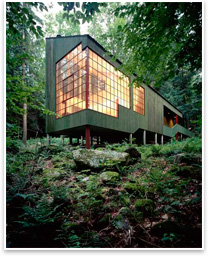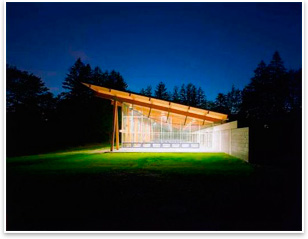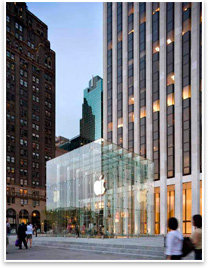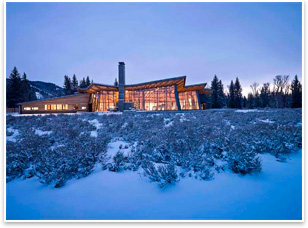|
Peter Bohlin, FAIA, Awarded the 2010 AIA Gold
Medal
by Zach Mortice
Associate Editor
Summary: The
American Institute of Architects’ Board of Directors awarded
the AIA Gold Medal to Peter Bohlin, FAIA, on December 3. The Pennsylvania-based
architect and founder of Bohlin Cywinski
Jackson is renowned for
his versatile, contextual use of materials. The AIA Gold Medal is
the highest honor the AIA confers, and acknowledges an individual
whose significant body of work has had a lasting influence on the
theory and practice of architecture. Bohlin will be honored at the
2010 AIA National Convention in Miami.

Peter Bohlin’s Forest House in Connecticut. Photo courtesy of Michael Thomas.
AIA President Marvin Malecha, FAIA, notified Bohlin by telephone
immediately after the Board made its decision. “I’m so
pleased and I’m surprised,” Bohlin said. “We all
believe in architecture. It is our life to a great extent. Like athletes,
we all know that it’s hard work to make it look easy, and we’re
all constantly striving to do that.”
The material language of place
Over the course of his long career, Bohlin has designed superlative
rural houses and nature centers. He’s also designed excellent
urban buildings. The key to success for both building types is
their contextual use of materials. He’s equally adept with
natural palettes of stone and timber on rural sites, like his Ledge
House in Maryland, as he is with steel and glass in urban places,
like his Seattle City Hall. From this common approach, Bohlin has
derived a variety of styles and aesthetics that consistently use
their materials to express the essence of their place. Whether
it be city skylines or mountain ranges, Bohlin’s deft use
of glass and transparency means that his projects feature perfectly
executed views out to awe-inspiring vistas. “He moves from
the log cabin to the glass box with the same unassailable ethic
that has for hundreds of years defined and shaped an architectural
tradition rooted in the exercise of knowledge and made unique only
by the personal will, character, and imagination of its creator,” wrote
Mack Scogin, FAIA, of Mack Scogin Merrill Elam Architects, in a
recommendation letter.

The Pocono Environmental Education Center, designed by Peter Bohlin. Photo courtesy of Nic Lehoux Photography Ltd. and Christopher Barone Architectural Photography.
Since he founded Bohlin Cywinski Jackson in 1965, Bohlin has evolved
a warm, even woodsy Modernism that sits apart from its rigid social-reformer
history. Perhaps his most accurate historical parallel is the Modernist
formal language developed by Frank Lloyd Wright meant to integrate
buildings with uniquely American landscapes. Bohlin’s closest
communion with this legacy came with the renovation of a 19th
century barn into
a conference
center adjacent to Wright’s Fallingwater
at Bear Run. Paul Goldberger,
Hon. AIA, the New Yorker’s architecture
critic, has called Bohlin a “romantic Modernist, determined
to use the form of Modernism to achieve the emotional impact of traditionalism.”
“His architecture clearly communicates that buildings are
not just placed on the landscape, but are part of the landscape and
indeed enhance the experience of nature,” wrote Ed Feiner,
FAIA, former General Services Administration chief architect, in
a letter of recommendation.

Bohlin’s Ballard Library and Neighborhood Center in Seattle. Photo courtesy of Nic Lehoux Photography Ltd. and Seattle Public Library.
Bohlin’s rural work communicates the rough-hewn yet stately
bravery of the American frontier, rediscovered and reappreciated
by the postcard views of nature they frame. His Grand Teton National
Park Visitors Center in Wyoming features jagged wood roof peaks and
canted planes that mirror the Teton Mountains beyond, and enclose
a hearth-like glowing heart walled in glass. Throughout Bohlin’s
body of work, sustainability is a consistent emphasis, though his
projects are never overwhelmed by superfluous sustainable gadgetry.
Alan Balfour, dean of the Georgia Tech College of Architecture, wrote
in a recommendation letter that Bohlin’s work embodies “a
metaphysical relationship with nature that is an elusive, yet profound
part of the cultural imagination of this nation.”
Humility and human aspiration
Examples of Bohlin’s work includes:

The 5th Ave. Apple Store in Manhattan. Photo courtesy Apple Inc. and Peter Aaron/Esto.
- The Ledge House, which builds a serene, natural light-bathed
retreat in Maryland’s Catoctin Mountain region Ridge Mountains
by arranging a series of timber and stone pavilions in a horseshoe
pattern.
- The William J. Nealon Federal Building and US Courthouse in
Scranton, Pa., which subtly integrates a new courthouse building
into the original 19th century Neo-Classical facility with a multi-story,
sky-lit atrium.
- The Apple Store 5th Ave. in New York City, a pure, pristine glass
cube absent any structural steel that takes visitors below ground,
away from its busy urban milieu, and into one of Apple’s
flagship retail destinations.
- The Pocono Environmental Education Center in Dingmans Ferry,
Pa., which distills Bohlin’s approach to nature center design
to its essence with basic shed massing, a broad, overhanging roof,
natural materials, and a luminous, lantern-like glow from within.
- Seattle City Hall; its varied curtain wall facades of steel and
glass uniquely reflect the solar orientation and urban fabric of
each face.

The Craig Thomas Discovery and Visitor Center
at Grand Teton National Park. Photo courtesy Nic Lehoux Photography Ltd. and Edward Riddell.
Bohlin and his 200-person practice, which has offices in Wilkes-Barre,
Pa., Pittsburgh, Philadelphia, Seattle, and San Francisco,
firm have shown a deference to site context and a tendency for design
humility that is becoming rarer and rarer among the top tier of practitioners.
Again and again, his work demonstrates that great cities, towns,
and buildings are created by designers looking to further the story
of their place in a collaborative and contextual way, not by singular
architecture that calls for heedless and self-serving attention.
Awarding the Gold Medal to Bohlin, wrote Scogin in his recommendation
letter, would communicate that “architects
can in fact address all the complexities of our present day world
with the grace and humility that privileges the best of human aspiration.”
Bohlin’s projects have earned 14 national AIA awards, including
9 Institute Honor Awards, COTE Top Ten Green Project Awards, AIA
Committee on Education Awards, and AIA Housing Awards. His firm received
the 1994 AIA Architecture Firm Award. Bohlin is the 66th AIA Gold
Medalist. He joins the ranks of such visionaries as Thomas Jefferson
(1993), Frank Lloyd Wright (1949), Louis Sullivan (1944), LeCorbusier
(1961), Louis Kahn (1971), I.M. Pei (1979), Frank Gehry (1999), and
Renzo Piano (2008). In recognition of his legacy to architecture,
his name will be chiseled into the granite Wall of Honor in the lobby
of the AIA headquarters in Washington, D.C. |






